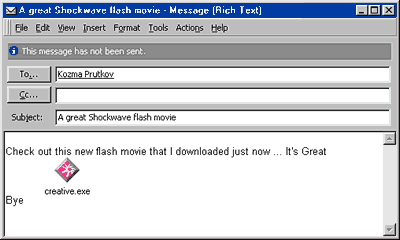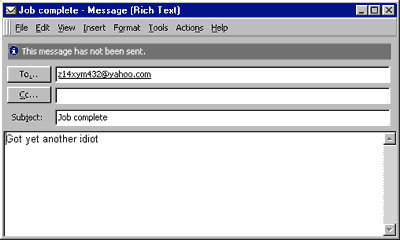Parent class: VirWare
Viruses and worms are malicious programs that self-replicate on computers or via computer networks without the user being aware; each subsequent copy of such malicious programs is also able to self-replicate. Malicious programs which spread via networks or infect remote machines when commanded to do so by the “owner” (e.g. Backdoors) or programs that create multiple copies that are unable to self-replicate are not part of the Viruses and Worms subclass. The main characteristic used to determine whether or not a program is classified as a separate behaviour within the Viruses and Worms subclass is how the program propagates (i.e. how the malicious program spreads copies of itself via local or network resources.) Most known worms are spread as files sent as email attachments, via a link to a web or FTP resource, via a link sent in an ICQ or IRC message, via P2P file sharing networks etc. Some worms spread as network packets; these directly penetrate the computer memory, and the worm code is then activated. Worms use the following techniques to penetrate remote computers and launch copies of themselves: social engineering (for example, an email message suggesting the user opens an attached file), exploiting network configuration errors (such as copying to a fully accessible disk), and exploiting loopholes in operating system and application security. Viruses can be divided in accordance with the method used to infect a computer:- file viruses
- boot sector viruses
- macro viruses
- script viruses
Class: Email-Worm
Email-Worms spread via email. The worm sends a copy of itself as an attachment to an email message or a link to its file on a network resource (e.g. a URL to an infected file on a compromised website or a hacker-owned website). In the first case, the worm code activates when the infected attachment is opened (launched). In the second case, the code is activated when the link to the infected file is opened. In both case, the result is the same: the worm code is activated. Email-Worms use a range of methods to send infected emails. The most common are: using a direct connection to a SMTP server using the email directory built into the worm’s code using MS Outlook services using Windows MAPI functions. Email-Worms use a number of different sources to find email addresses to which infected emails will be sent: the address book in MS Outlook a WAB address database .txt files stored on the hard drive: the worm can identify which strings in text files are email addresses emails in the inbox (some Email-Worms even “reply” to emails found in the inbox) Many Email-Worms use more than one of the sources listed above. There are also other sources of email addresses, such as address books associated with web-based email services.Read more
Platform: Win32
Win32 is an API on Windows NT-based operating systems (Windows XP, Windows 7, etc.) that supports execution of 32-bit applications. One of the most widespread programming platforms in the world.Description
Technical Details
This is a virus-worm that spreads via the Internet by using MS Outlook. The worm itself is a Windows EXE file about 37Kb in length, and written in VisualBasic. The worm uses a standard MW97_Melissa-like way of spreading: it opens the MS Outlook address book, obtains addresses from there, and sends its copies to these addresses. The message reads as follows:
Subject: A great Shockwave flash movie
Message text:Check out this new flash movie that I downloaded just now ... It's GreatAttach name: creative.exe
Bye

The worm then sends a "notification" message to its author and informs him about the next infected computer:
To: z14xym432@yahoo.com
Subject: Job complete
Message text: Got yet another idiot

The worm also creates its copies on the C: disk with the following names:
C:creative.exe
C:WINDOWSStart MenuProgramsStartUpcreative.exe
The second copy is placed in the auto-run directory so it will be activated upon each Windows restart.
The worm has a dangerous payload. It scans all disk drives, obtains ZIP, MP3, and JPG files, and renames them to C: drive with the following name:
C:%victimfile%change atleast now to LINUX
for example, BGAMEX.JPG and DATA.ZIP are moved to:
C:BGAMEX.JPGchange atleast now to LINUX
C:DATA.ZIPchange atleast now to LINUX
The worm also creates the text file "c:messageforu.txt", writes the text there and adds list of removed files, such as the following:
Hi, guess you have got the message. I have kept a list of files that I
have infected under this. If you are smart enough just reverse back the
process. i could have done far better damage, i could have even
completely wiped your harddisk. Remember this is a warning & get it sound
and clear... - The Penguin
C:WINDOWSSYSTEMOOBEIMAGEXBGAMEX.JPG
C:BACKUPDATA.ZIP
Read more
Find out the statistics of the vulnerabilities spreading in your region on statistics.securelist.com